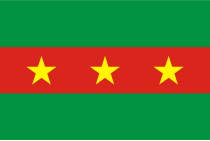Anlo state
 |
|
| Regions with significant populations | |
|---|---|
|
|
|
| Languages | |
| Ewe | |
| Religion | |
| Predominantly Vodun, with a small Islam and Christian minority | |
| Related ethnic groups | |
| Anlo Ewe is a sub-group of the Ewe people, Avenor Ewe, |
The Anlo Ewe are a sub-group of the Ewe people of approximately 6 million people, inhabiting southern Togo, southern Benin, southwest Nigeria, and south-eastern parts of the Volta Region of Ghana; meanwhile, a majority of Ewe are located in the entire southern half of Togo and southwest Benin. They are a patrilineal society governed by a hierarchal, centralized authority. Their language (self-name Anlogbe) is a dialect of the Ewe language, itself part of the Gbe language cluster. The Ewe religion is centered on a supreme god Mawu and several intermediate divinities.
The name nlo (of Anlo) is said to derive from the Ewe term 'nlo' which means rolling up or folding into oneself.
The Ewe people are traced back to their original settlement in the Oyo State of western Nigeria. It is thought they migrated to their present home from Notsie, Togo sometime in the later part of the seventeenth century. The move is said to be more of an escape than migration from a regime change in the city. Upon first arrival in Notsie, the current king, Adela Atogble, received them well, but after his death the successor, Agorkoli, ruled oppressively upon the Ewe. He ordered all elders killed . The city of Notsie was circumscribed by a large defensive wall which became a barrier to the Ewe devising escape. Upon consultation of the hidden elder, Tegli, the Ewe came up with an extravagant plan of escape. For days the women of the group would moisten the wall in one place during their daily clothes washing activities. When the wall was weak enough, the plan then culminated in the gathering of all the Ewe, Tegli drawing the “Sword of Liberation” summoning the gods, and piercing the wall proclaiming, “O Mawuga Kitikata, ʋuʋɔ na mi ne miadogo, azɔ adzo” (Oh great God Kitikata, open the door for us so that we walk through).
Most groups settled in villages in coastal regions of Togo, Benin, with some settling in south-eastern parts of the Volta Region of Ghana, many of which are associated with the slave trade that affected the Ewe populations. The Avenor Ewe settled to the north of the Anlo and are now to be found in Akatsi South District and Akatsi North District. A northern migration was the result of frequent slave raids and spread the Ewe people throughout southern Togo, southern Benin to south-western Nigeria. The shallow waters and many islands of Bight of Benin provided a safe-haven to all but the most aggressive slave traders.
...
Wikipedia
